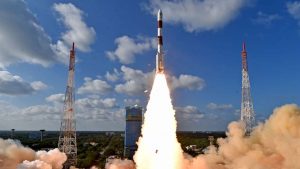 New Delhi : Indian Space Research Organization (ISRO) Chairman K Sivan on Wednesday lauded the successful launch of RISAT-2BR1 and nine commercial satellites by the Polar Satellite Launch Vehicle (PSLV), in its fiftieth flight (PSLV-C48) from Satish Dhawan Space Centre (SDSC) SHAR in Sriharikota, Andhra Pradesh.
New Delhi : Indian Space Research Organization (ISRO) Chairman K Sivan on Wednesday lauded the successful launch of RISAT-2BR1 and nine commercial satellites by the Polar Satellite Launch Vehicle (PSLV), in its fiftieth flight (PSLV-C48) from Satish Dhawan Space Centre (SDSC) SHAR in Sriharikota, Andhra Pradesh.
The PSLV-C48 lifted-off at 3.25 pm (IST) from the First LaunchPad. After 16 minutes and 23 seconds, RISAT-2BR1 was successfully injected into an orbit of 576 km. Subsequently, nine commercial satellites were injected into their intended orbits. After separation, the two solar arrays of RISAT-2BR1 were deployed automatically and the ISRO Telemetry Tracking and Command Network at Bengaluru assumed control of the satellite. In the coming days, the satellite will be brought to its final operational configuration.
RISAT-2BR1 is a radar imaging earth observation satellite weighing about 628 kg. The satellite will provide services in the field of Agriculture, Forestry and Disaster Management. The mission life of RISAT-2BR1 is five years. The nine customer satellites of Israel, Italy, Japan and the US were precisely injected into their designated orbits. These satellites were launched under a commercial arrangement with NewSpace India Limited (NSIL).
PSLV-C48 is the 2nd flight of PSLV in ‘QL’ configuration (with 4 solid strap-on motors). Besides being the 50th launch of PSLV, Wednesday’s launch was also the 75th launch vehicle mission from SDSC SHAR, Sriharikota.
Taking to Twitter, ISRO said, “It was a dream come true for over 7,000 visitors who witnessed the launch of PSLV-C48 live from the Viewers gallery in Sriharikota.”
The PSLV is a four-stage rocket with the first stage and third stage using solid-propellant rocket motors, whereas the second a fourth stage use liquid-propellant rocket motors. It is considered to be the most reliable launch vehicle of ISRO as it has flown 47 of its 49 missions successfully. The only failures of missions involving the PSLV rocket occurred in 1993 (first launch) and 2017 (41st launch).
In its maiden mission, there was a software error in an on-board guidance and control processor, while the 2017 failure was caused as the heat shield (the bulbous top portion that holds the satellite) had failed to separate, thus preventing the satellite from being placed in orbit.
Bureau Report
Leave a Reply